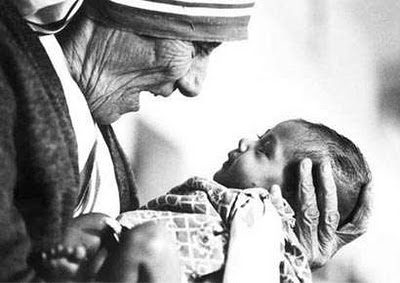
Mother Teresa is a household name for her good works, but many people don’t know much about her beyond “nun who helped the poor.” On the anniversary of her being awarded the Nobel Peace Prize, here are 20 facts about Mother Teresa.
1. She was born Agnes Gonxha Bojaxhiu in 1910 in Albania, to a financially comfortable family – they lived in one of the two houses they owned. Her father died when she was 8 years old, which ended her family’s financial security.
2. Agnes was fascinated with missionaries from an early age, and she knew by age 12 that she would commit herself to a religious vocation.
3. When she was 18 years old, Agnes left home and joined the Sisters of Loreto in Rathfarnham, Ireland.
4. Although she lived to be 87 years old, she never saw her mother or sister again after the day she left for Ireland.
5. After a year learning English in Ireland, Agnes transferred to the Sisters of Loreto convent in Darjeeling, India.
6. She took her vows as a nun in 1931, and that’s when she chose the name Teresa – to honor Saints Therese of Lisieux and Teresa of Avila.
7. Therese of Lisieux is the patron saint of missionaries – which attracted Agnes to her – as well as the patron saint of florists, Australia, AIDS sufferers and others. Teresa of Avila is the patron saint of people in religious orders, lacemakers, Spain and more.
8. Teresa began teaching history and geography in Calcutta at St. Mary’s, a high school for the daughters of the wealthy. She remained there for 15 years and enjoyed the work, but was distressed by the poverty she saw all around her.
9. In 1946, Teresa traveled to Darjeeling for a retreat. It was on that journey that she realized what her true calling was: “I heard the call to give up all and follow Christ into the slums to serve him among the poorest of the poor.”
10. It took two years of preparation before she was able to begin doing the work she felt compelled to do. She needed to receive permission from the Sisters of Loreto to leave the order – while retaining her vows – as well as permission from the Archbishop of Calcutta to live and work among the poor. She also prepared by taking a nursing course.
11. In 1948, Teresa set aside her nun’s habit – adopting instead the simple sari and sandals worn by the women she would be living among – and moved to a small rented hovel in the slums to begin her work.
12. Teresa’s first year in the slums was particularly hard. She was used to a life of comparative comfort, and now she had no income and no way to obtain food and supplies other than begging. She was often tempted to return to convent life, and had to rely on her determination and faith to get herself through it.
13. One of her first projects was to teach the children of the poor – drawing on her experience with teaching the children of the rich. She didn’t have any equipment or supplies this time, but she taught them to read and write by writing in the dirt with sticks.
14. In addition to promoting literacy, Teresa taught the children basic hygiene. She visited their families, inquiring about their needs and helping provide for them when she could.
15. Word began to spread about Teresa’s good works, and soon she had other volunteers wanting to help. By 1950, she was able to start the Mission of Charity – a congregation dedicated to caring for “the hungry, the naked, the homeless, the crippled, the blind, the lepers, all those people who feel unwanted, unloved, uncared for throughout society, people that have become a burden to the society and are shunned by everyone.”
Mother Teresa 16. She went on to open a hospice for the poor, a home for sufferers of leprosy, and a home for orphans and homeless youths.
17. Mother Teresa was honored with many awards throughout her life, from the Indian Padma Shri in 1962 to the inaugural Pope John XXIII Peace Prize in 1971 to Albania’s Golden Honour of the Nation in 1994…and, most famously, the Nobel Peace Prize in 1979.
18. She refused the traditional Nobel honor banquet, instead requesting that the $192K funds be given to help the poor of India.
19. She continued her work with the poor for the rest of her life, leading the Missionaries of Charity until just months before her death on September 5, 1997.
20. The Catholic Church has begun to move Mother Teresa along the steps toward sainthood, and she was beatified in 2003. Her official title is now Blessed Teresa of Calcutta.
